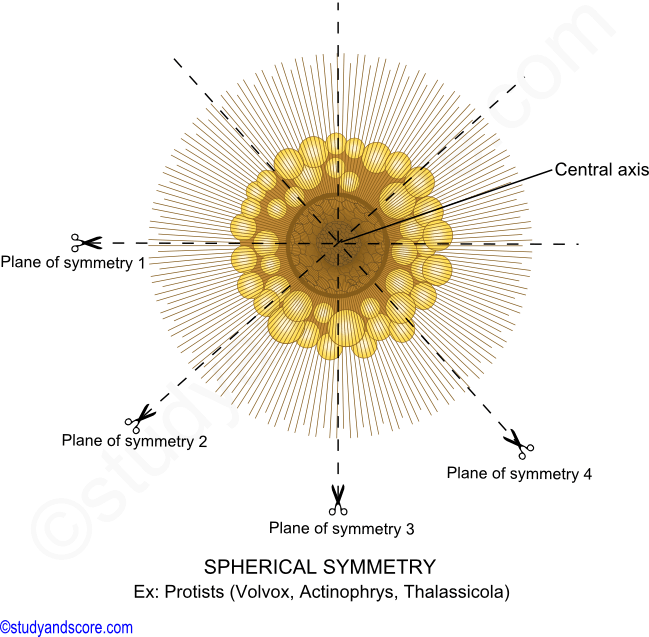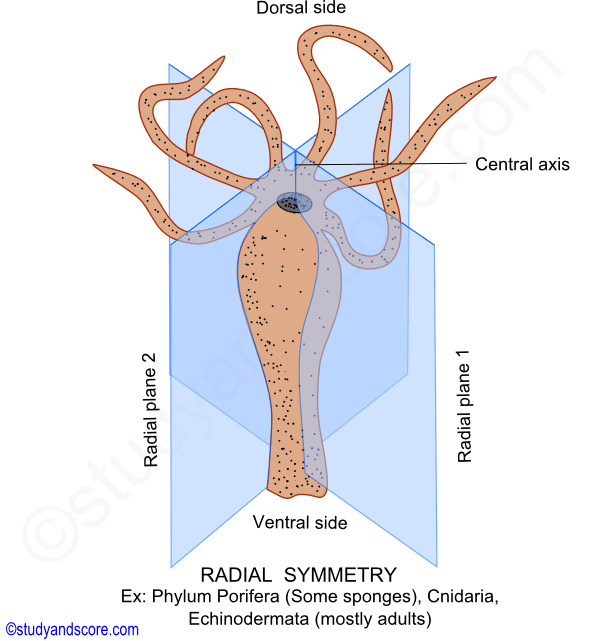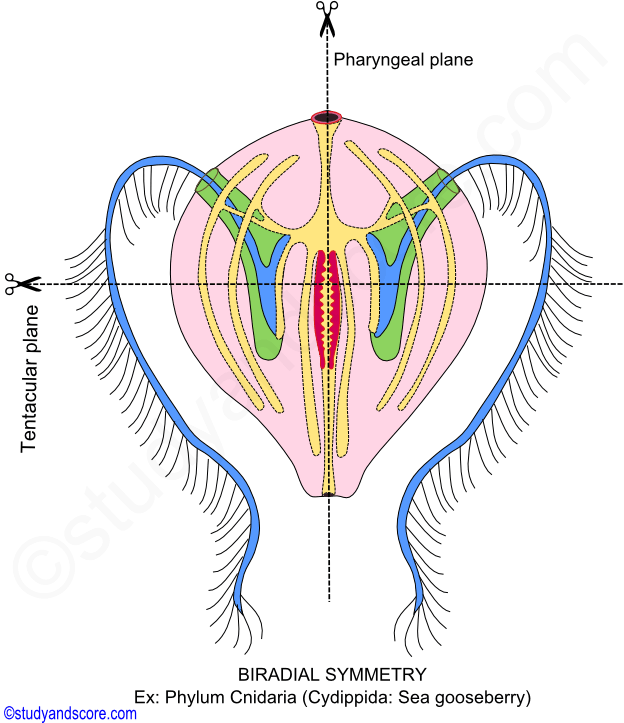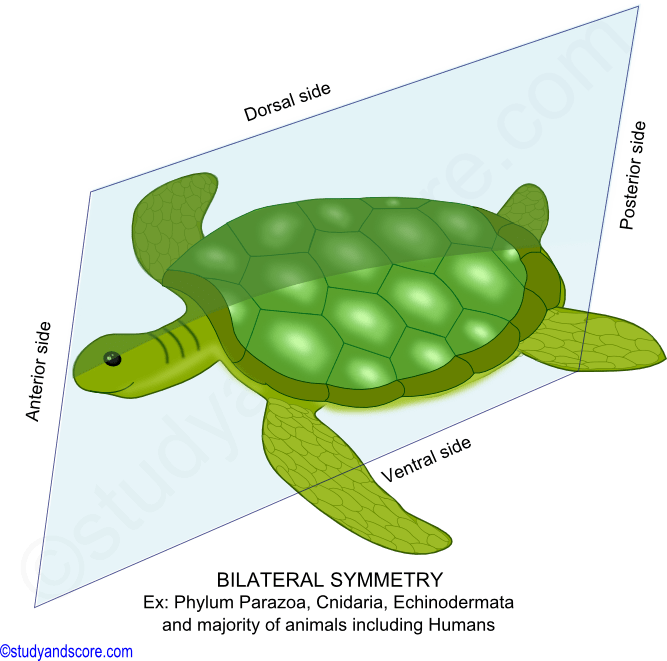Which Of The Following Animals Is Radially Symmetrical
Symmetry Introduction
Arrangement of body parts in a balanced geometrical design, divisible into equal parts past planes of division is called symmetry. The thought of symmetry is mainly derived from Ernst Haeckel.
An fauna is said to be symmetrical simply when a plane passing through its center will split it into similar halves. When an animal cannot be divided into similar halves information technology is said to be asymmetrical.

Asymmetrical animals such as Amoeba or sponges possess irregular trunk shapes and hence take no symmetry but higher metazoans possess some kind of symmetry depending on their habits and habitats that balances their activities. All animals are either symmetric or disproportionate. An centrality is an imaginary line passing through the center of body. Either end of the axis is termed as pole. Thus each axis has two poles. A plane of symmetry is a direct line that divides an animal into ii equal halves.
Types of Symmetry
ane. Spherical symmetry: Information technology is found in the animals whose body is ball-similar and all planes passing through the centre of torso volition cutting the animal into equal halves. This type of symmetry is suited for rolling movement, for floating in water or in sedentary habits in which case food is available in all directions. Body organs like cilia or tentacles are located all effectually the body in a radiating mode. For example, Volvox, Actinophrys (Heliozoa) and Thalassicola (Radiolaria)

2. Radial symmetry:This type of symmetry is institute in Coelenterates and Echinoderms in which Body parts are arranged along the main longitudinal axis of trunk. It is best suited for sessile existence where food is planktonic and bachelor in abundance in all directions. Food capturing organs are therefore bundled radially and the animate being does not have to move in search of food. Some of the Echinoderms, similar star fishes, accept given up their sessile existence to get hunters in pursuit of larger prey but not their bequeathed radial symmetry.

3. Biradial symmetry: Biradial symmetry is a mixture of bilateral and radial symmetry. This is plant in Ctenophores which are not sedentary but floating animals and show a mixture of bilateral and radial symmetries. Animals such equally Pleurobrachia have oval body on which eight comb plates are radially arranged like bands and are used for swimming, whereas mouth, anal pore and statocysts are placed on the anterio-posterior centrality.

They also have a pair of retractile tentacles that bear colloblasts which secrete sticky substance that helps in capturing planktonic food on which they feed. Tentacles demonstrate bilateral symmetry whereas comb plates show radial symmetry and the animal takes advantage of both symmetries for nutrient hunting and active swimming.
4. Bilateral symmetry: This type of symmetry is found in virtually of the higher animals to a higher place Platyhelminthes and is best suited in animals which move in a definite direction, due to which the sense organs and nervous organization concentrate on the inductive side and locomotory organs go paired for counterbalanced propulsion of torso.

A unmarried line passing through the longitudinal axis will divide the body into ii equal halves in such a way that one half is a mirror paradigm of the other. Flat worms were the first bilaterally symmetrical animals and other higher groups such as annelids, arthropods, some mollusks and chordates are all bilaterally symmetrical.
Bilateria and Radiata
Eumetazoa is divided into two groups by Hatschek. These ii groups Radiata and Bilateria are divided depending on the symmetry they possess. Radiata includes Coelenterates and Ctenophores and bilateria includes all phyla starting from Helminths to chordates.
Bilaterial animals: Bilaterians are bilaterally symmetrical animals. These are the animals that tin but be cut in one plane to create a single mirror paradigm. They have height (dorsal), bottom (ventral), head (anterior), tail (posterior), correct, and left sides. Cephalization is another important feature of Bilaterians. Cephalization is the concentration of nervous tissue in the head region.

Bilaterians accept bodies that develop from three unlike germ layers namely the endoderm, mesoderm, and ectoderm. They are called triploblastic. Except for a few highly reduced forms, the Bilaterians take consummate digestive tracts with separate mouth and anus. Most Bilateria also have a type of internal body cavity, chosen a coelom.

Almost of the phyla are bilaterians with exceptions of Sponges of Parazoa and Cnidarians. Likewise most notable exception is echinoderms, which are radially symmetrical every bit adults, but are bilaterally symmetrical as larvae.
Radial animals: Radiata are radially symmetrical animals. These are the animals that tin can be divided multiple times through a central axis creating multiple mirror images. They accept a meridian and a lesser merely no left nor right, no head nor tail. The best example is Phylum Cnidaria which includes jelly fish and sea anemones. Radiata have bodies that develop from two dissimilar germ layers, called the ectoderm and endoderm hence they are diploblastic.

Difference between Bilateria and Radiata
| Radiata | Bilateria |
|---|---|
| Body radially or biradially symmetrical | Trunk is bilaterally symmetrical |
| Sometimes bilateral symmetry is the adaptation in some animals | Sometimes radial symmetry is the secondary adaptation in some animals |
| Organ systems are non well marked | Organ systems are well marked |
| Mesoderm is not developed so the animals of the grade radiata are diploblastic in nature | Mesoderm is well developed so the animals of the grade bilateria are triploblastic in nature |
| Coelo crenel is invariably absent | Coelom can be pseudocoelom or true coelom or may be absent-minded |
| Tentacles with nematocycts are present | Tentacles if present take no nematocycts |
| Comb plates (locomotory organs) are present | Comb plates are absent |
| Principal external opening of the digestive cavity is oral cavity | External opening of the digestive cavity are mouth and anus |
Theories to explain the origin of Bilateria from Radiata
It is universally believed that the offset metazoans were radially symmetrical and bilateral symmetry evolved after attributable to the creeping habit acquired by the animals to feed on detritus on the bottom. The following are the theories put forth in support of evolution of Bilateria from Radiata.
Ctenophore-polyclad theory:
Proposed by Kovalevsky and Arnold Lang. It emphasizes that polyclads evolved from ctenophore-like ancestor. Mod polyclads, such as Leptoplana and Notoplana are marine, free-living, bottom dwelling turbellarians that belong to Order Polycladida or Phylum Platyhelminthes. They creep on the bottom and use their ventral mouth to feed on detritus. On the other manus ctenophores are freely floating animals exhibiting radial equally well as bilateral symmetry aka biradial symmetry.
Ciliary bands are radially placed on the body while a pair of antennae is bilateral. A ctenophore-like ancestor could have given rise to bilaterally symmetrical animals past acquiring lesser itch mode of life. Some crawling ctenophores existing today are Ctenoplana and Coeloplana.
Ctenophore-trochophore theory:
This theory takes into consideration the larval stages of Coelenterates, Ctenophores, Helminthes and Annelids and tries to establish evolutionary relationship among them.
Planula larva of coelenterates has elongated and cylindrical body that is ciliated all over. Cydippid larva of ctenophores is also ovoid in shape just has longitudinal ciliary bands arranged radially around the trunk. Muller'south larva of Polycladida too has ciliary bands on swimming arms and apical tuft of cilia on the anterior side. Mouth is ventral in this larva and there is no anus.
The trochophore larva of Polychaeta resembles Muller's larva in having ciliary bands and apical tuft of cilia and ventral mouth. Since Cydippid larva of ctenophore, Muller's larva of polyclads and trochophore larva of polychaetes all resemble 1 another in structure and ciliary band, this theory considers larvae of acoelomate bilateria (flat worms) as early stages of trochophore.
Planuloid-Acoeloid theory:
Proposed by Ludwig von Graff and the elaborated by Hyman. The theory postulates that the archaic acoelomate bilateria evolved from some planuloid ancestor which was very similar to the planula larva of coelenterates. The planuloid ancestor must have been complimentary-living, radially symmetrical, ciliated and with a diffused nerve net.
Such planuloid larvae must have developed into a gastrula-similar ancestor by the formation of oral fissure and archenteron and adopted a bottom creeping mode of living rather than gratis swimming habit of planula. Creeping addiction produced cephalization of nervous system towards the anterior side and since the food was available at the bottom, the anterior mouth moved to the ventral side and the body became dorso-ventrally flattened, as is the case in turbellarian Helminthes of today.

- What are bilaterians? Give out examples.
- Requite examples of Radially symmetrical animals.
- Elucidate on the theories which explicate the origin of Bilateria from Radiata.
- What is Symmetry?
- How many types of symmetry tin can be identified in animals?
- What is Plane of Symmetry?
- Give out examples for Spherical and bilateral symmetry?
- Share with your friends! -
Source: https://www.studyandscore.com/studymaterial-detail/symmetry-in-animals-types-of-symmetry-bilateria-and-radiata
Posted by: madisonwidefirearm.blogspot.com

0 Response to "Which Of The Following Animals Is Radially Symmetrical"
Post a Comment